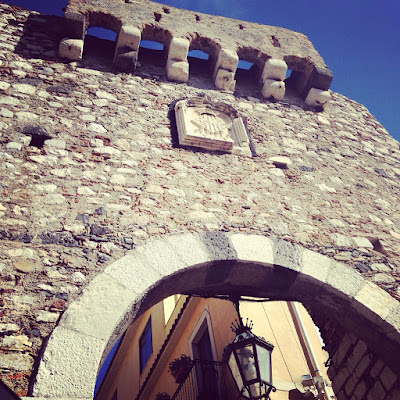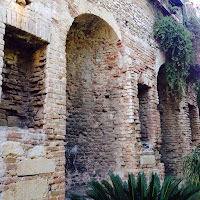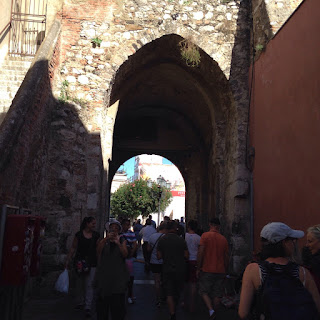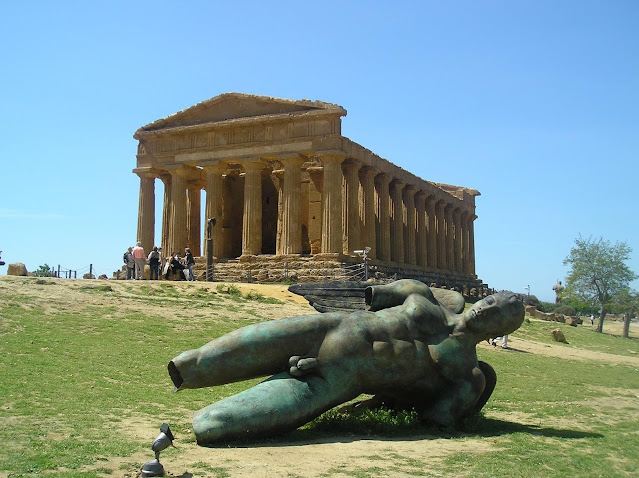Taormina ... The Story and 18 Historical Places you must see
 |
| Porta Catania ... Taormina's Southern Gateway |
Taormina … the
Pearl of the Ionian Sea, a town of myth and legend, a destination for the
international Jet Set and one of the most beautiful parts of Sicily.
The town has incredible energy, beautiful colours, exciting
aromas, the tastes of authentic Sicilian cuisine and is full of rich Ancient History.
A Brief History of
Taormina
Taormina was founded in 358 in the period when the Greek
colony of Naxos was being destroyed by the tyrant Dionysius of Syracuse. The
people of Naxos looked towards the mountains for a new settlement. The Greeks
named the town Tauromenion.
Thereafter the Romans invaded the town and named it
Tauromenium. It was the Romans who added most of the splendour to the town. In
fact the remains of many magnificent Roman monuments can still be seen today in
Taormina.
The town was neglected and suffered decay in the last days
of the Roman period but was born again during the presence of the Byzantine
Empire. The Byzantine nobles preferred it to be their place of residence and
enriched Taormina with many architectural monuments.
In 902 the town was invaded by the Arabs who destroyed it
almost completely and killed almost the entire population of Taormina.
A new life came to the town with the arrival of the
Christians who named the reconstructed town New Taormina. But it did not last
for long as the Arabs returned in 962 guided by the Emir Ahmed. After this
occupation Taormina was given the name Almezia, in honour of the Caliph of
Bagdad, its new ruler.
In 1078 the town, which at this time resembled a Muslim
fortress, was liberated by the Normans after a siege that lasted for five
months. The liberation was made possible by the union of the Normans with the
Aragonese.
In 1410 Taormina became an official seat of the Sicilian Parliament,
Taormina remained faithful to the Aragonese supporting them in the war against
Messina in 1675 which at that time was occupied by the French.
In 1860 the citizens of Taormina rose up against the
Bourbons opening the city gates to Garibaldi’s army.
Ever since this time Taormina lost its status as a fortress
and the defence of the Ionian coast and gained the reputation of an
international tourist destination which it still enjoys to this day.
18 Historical
Places Not to Miss
Corso Umberto
The main pedestrianised street Corso Umberto runs from Porta
Messina to Porta Catania and is 800 metres long. Historically it was the main
part of the most important route for travellers between the cities of Messina
and Catania, the ancient street was then known as Via Valeria.
Via Valeria connected the coastline at Spisone with the
North gate of the town at Porta Messina towards Porta Catania and then back
down the valley towards Giardini Naxos.
Until the last century, when the construction of the Highway
SS114 was completed, Via Valeria was the only way to get from one end of the
Ionian Coast to the other. Corso Umberto is at the heart of Taormina’s centre
where you can see the following monuments;
 |
| Palazzo Corvaja |
Piazza Vittorio Emanuele
This was the main meeting point for the Agora, the Greek assembly and afterwards the forum for the Romans.
Palazzo Corvaja
In 1410 this was where the official seat of the Sicilian
Parliament was situated. Here you can see different historical periods in the
architecture, including Arabic and Norman. Today you will find the tourist
information centre located inside.
Chiesa Santa Caterina
and The Roman Odeon
The Church of Saint Catherine was built in the 17th
Century on the remains of a Roman theatre (Odeon). The remains date back to the
times of Caesar Octavian Augustus which can be seen behind the church and is also
visible inside.
 |
| Naumachie |
Naumachie
To the left of Corso Umberto from Porta Messina there is Via
Naumachie, representing one of the most important monuments of architecture
from Roman times. There is a long brick wall which consists of niches with
round arches. It is thought that it was once used as a gymnasium for Roman
soldiers.
Piazza IX Aprile
This is the central piazza with wonderful sea views where
you can see;
Chiesa di
Sant’Agostino
This church was built in 1448 and is nowadays the town’s
library.
Chiesa di San
Giuseppe
This cathedral was built in the 17th Century and
is connected with a bell tower. The entrance to the church is accessed by two
beautiful staircases.
 |
| Chiesa di San Giuseppe, Piazza IX Aprile |
The Middle Gate (The Clock
Tower)
This was the third wall of the city fortress in the middle
ages. It is situated under the clock tower and was built between the 11th
and 12th Century, this is where the medieval town was founded.
Palazzo Ciampoli
This is the remains of a typical palace of the 15th
Century.
Chiesa Madre
(Cathedral of San Nicola)
Leaving Piazza Aprile heading towards Porta Catania this cathedral
was built during the reign of King Frederic III of Aragon.
Chiesa e Convent di
San Domenico
Slightly off from Corso Umberto the building of the church
and convent began in 1347 on the remains of the family Castle of Rosso di
Cerami. The church was finished in 1500 together with the main building. Other
parts including the bell tower were added in the 18th Century. The
building suffered bomb damage in 1943 during World War II. Now San Domenico is
one of Taormina’s most elite hotels, favoured by the fashion designers Dolce
and Gabbana for photo shoots.
 |
| Cathedral of San Nicola and Quattro Fontane |
Quattro Fontane
In Piazza Duomo in front of the Cathedral of San Nicola,
this Baroque fountain was built in 1635. It is said if you drink from this
fountain you will stay forever young.
Badia Vecchia
This is one of Taormina’s most beautiful buildings, it is
the remains of a 15th Century abbey and is now home to the towns Museum of Archaeology
displaying relics from Roman times.
Palazzo Duchi di
Santo Stefano
This 14th Century palace near Porta Catania is
part of the original city wall and is now a popular venue for wedding
ceremonies.
Ex-Chiesa San Antonio
Just beyond Porta Catania this was a smaller church with a
bell tower that dates back to the 14th Century. Nowadays it is the
home of the town’s Christmas nativity scene where you can see the famous
buildings of Taormina in miniature.
Teatro Greco Antico
(The Greek Theatre)
The Greek Theatre was built in Greek times but was
reconstructed during the Roman Empire period. The theatre is divided into three
parts, the stage, the orchestra pit and the spectator’s area. The natural curve
of the hill was used to build the spectator’s area. The stage was constructed
creating a natural backdrop with the Bay of Naxos and Mount Etna as scenery.
 |
| Teatro Greco ... The Greek Theatre |
Byzantine Tombs
Away from Corso Umberto you can see these tombs on the upper
part of Via Pirandello. There are about 50 tombs built into a thick wall in two
rows. This is where the Arab’s necropolis (cemetery) was situated during their
invasion of Taormina.
There are many ways to experience Taormina ... why not book a walking tour?
Please feel free to Email me at sarah@whitealmond-privatesicily.com for my top recommendations
Please feel free to Email me at sarah@whitealmond-privatesicily.com for my top recommendations
 |
| Byzantine Tombs on Via Pirandello |
 |
| Byzantine Mosaic under the Middle gate |
 |
| Piazza IX Aprile and the Middle Gate Clocktower |
 |
| Middle Gate of Taormina |
 |
| Palazzo Corvaja Details |
 |
| Palazzo Duchi di San Stefano |
 |
| I Heart Taormina <3
Thank you for following me at White Almond Sicily
For NEW Blog updates and all things Sicilian
follow me on Facebook at www.facebook.com/whitealmondprivatesicily/
You can also follow me on
Twitter @sicilyconcierge Instagram @whitealmondsicily Pinterest and Linkedin
I am also a contributor to www.timesofsicily.com
Email me at WhiteAlmondSicily@Gmail.Com
for Travel Advice and Reccomendations Love Sarah
|


